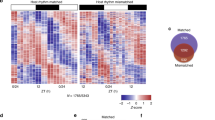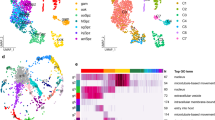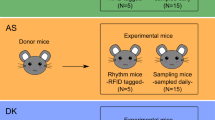Abstract
The life cycle of the malaria parasite Plasmodium falciparum goes through three developmental stages (schizogony, gametogony and sporogony), each of which presents different environmental constraints that must be met by an adaptive response in the parasite. Here we show that thermoregulation, in which the transcription of select RNAs is upregulated at cooler temperatures, is crucial to the developmental transition that occurs during the transmission of P. falciparum from human to mosquito. Our findings offer new insight into how the malaria parasite senses and reacts to its environment.
Similar content being viewed by others
Main
Switching between two sequence types of ribosomal RNA (designated A and S) occurs during the developmental cycle of Plasmodium1,2,3,4,5. Although the resulting ribosomes still translate messenger RNA into protein, there are functional variations between the two types6. Polymorphisms in the sequences preceding two mature A-type rRNAs (A1, A2; GenBank accession numbers, AF503871 and AF5033868) and two mature S-type rRNAs (S1, S2; GenBank accession numbers, AF 503869 and AF503870) enabled us to follow the regulation of transcription of each precursor independently7 by real-time polymerase chain reaction. We found that precursors A1 and A2 are the predominant forms during schizogony, whereas S1 predominates during gametogony and S2 during sporogony.
We investigated the effect of temperature as a differential regulator of transcription. A single asexual parasite culture was split and the portions were incubated for 3 h at four different temperatures (Fig. 1a). The transcription of A1 and A2 remained relatively constant, but the rate of S-gene transcription was sensitive to temperature: at 42 °C, neither S gene was transcribed; S2 transcription increased 4.4-fold at 31 °C and 15-fold at 26 °C (monitored for comparison with S2 transcription at 37 °C). The S1 gene was affected by decreasing the temperature, but not as markedly.
a, Transcription of individual genes (see text) at different temperatures likely to be encountered by Plasmodium falciparum. Results in asexual blood-stage parasites were determined by real-time polymerase chain reaction; the amount of transcription at 37 °C was taken as unity. b, Nuclear run-on analysis of the variation in transcription from ribosomal RNA genes with temperature. c, Changes over time in the relative levels of transcription at 26 °C and 37 °C of the different rRNA genes during the asexual blood stage. d, Changes over time in the relative levels of transcription at 37 °C and 26 °C of rRNA genes in mosquito-stage parasites.
We used nuclear run-on analysis8 to confirm this pattern of temperature regulation (Fig. 1b). We also measured the rates of transcription of three mRNAs, namely those encoding the P. falciparum proteins HRPIII, MSP-1 and CSP (Fig. 1a). Our findings are consistent with the rRNA results in that the levels of the mRNAs associated with schizogony, HRPIII and MSP-1, tend to fall off at reduced temperature, whereas CSP mRNA, which is associated with sporogony, increases. If the duration of culture is extended to 7 h, the difference in S2 transcription at 26 °C and at 37 °C is more than 20-fold (Fig. 1c).
This transcriptional control is evident by simply altering the temperature of the mosquito itself: we find that transcription of the S2 gene, but not of the other rRNA genes, is inhibited by warming (Fig. 1d).
A strong, cold-stimulated promoter might be responsible for this selective control of transcription. When we transfected P. falciparum with a chimaeric plasmid containing an S2 promoter region aligned with a fragment of the luciferase gene, we found that promoter control was fully operative over the range of temperatures at which P. falciparum is viable in culture (results not shown).
Temperature control is important with regard to malaria, given that vacillating ambient temperatures affect the rate of development of P. falciparum in the mosquito9. Our results provide a framework for understanding how the malaria parasite responds to its environment, as well as indicating how this process might be investigated further.
References
Waters, A. P., Syin, C. & McCutchan, T. F. Nature 333, 74–76 (1988).
Gunderson, J. H. et al. Science 238, 933–937 (1987).
McCutchan, T. F. et al. Mol. Biochem. Parasitol. 28, 63–68 (1988).
Li, J., Wirtz, R. A., McConkey, G. A., Sattabongkot, J. & McCutchan, T. F. Mol. Biochem. Parasitol. 65, 283–289 (1994).
Rogers, M. J. et al. RNA 2, 134–145 (1996).
Velichutina, I. V., Rogers, M. J., McCutchan, T. F. & Liebman, S. W. RNA 4, 594–602 (1998).
Waters, A. P. et al. J. Biol. Chem. 272, 3583–3589 (1997).
Rosalina, M. L. et al. Mol. Biochem. Parasitol. 99, 193–205 (1999).
Noden, B. H., Kent, M. D. & Beier, J. C. Parasitology 111, 539–545 (1995).
Author information
Authors and Affiliations
Corresponding author
Ethics declarations
Competing interests
The authors declare no competing financial interests.
Rights and permissions
About this article
Cite this article
Fang, J., McCutchan, T. Thermoregulation in a parasite's life cycle. Nature 418, 742 (2002). https://doi.org/10.1038/418742a
Issue Date:
DOI: https://doi.org/10.1038/418742a
This article is cited by
-
The 18S rRNA genes of Haemoproteus (Haemosporida, Apicomplexa) parasites from European songbirds with remarks on improved parasite diagnostics
Malaria Journal (2023)
-
Typical structure of rRNA coding genes in diplonemids points to two independent origins of the bizarre rDNA structures of euglenozoans
BMC Ecology and Evolution (2022)
-
The nuclear 18S ribosomal DNAs of avian haemosporidian parasites
Malaria Journal (2019)
-
Erratum: Corrigendum: Malaria: Thermoregulation in a parasite’s life cycle
Nature (2016)
-
Sir2a regulates rDNA transcription and multiplication rate in the human malaria parasite Plasmodium falciparum
Nature Communications (2013)
Comments
By submitting a comment you agree to abide by our Terms and Community Guidelines. If you find something abusive or that does not comply with our terms or guidelines please flag it as inappropriate.




